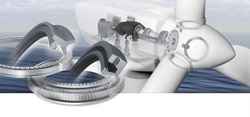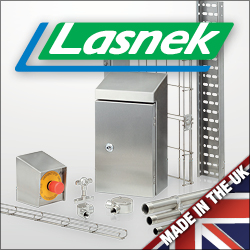
Posted to News on 27th Jun 2014, 13:13
Optimised seals for wind turbine rotor, blade and tower bearings
Wind turbines must operate reliably in a diverse range of environmental conditions, both onshore and offshore. By optimising the bearing design, lubrication and sealing for wind turbine rotors, blades and tower, reliability and operating life are maximised, says Dr Steve Lacey, Engineering Manager at Schaeffler UK.

Rotor, blade and tower bearings are fundamental components of a wind turbine. The functional reliability of these bearings is critical to the long-term, efficient and defect-free operation of the wind turbine installation.
The varied and often extreme loads on a wind turbine require a carefully matched combination of bearing design, lubrication and bearing sealing. This means that a packaged system for each bearing position is required, which is optimally matched to the specific application.
Wind turbines are now installed in locations with a wide variety of climatic conditions, both onshore and offshore. The operating temperatures expected of a wind turbine can range from -30degC in Arctic regions to +60degC in sub-tropical climates. Depending on the location, the installation is exposed to varying levels of ozone, UV light, sand, dust and salt water. In order to ensure maximum availability of a wind turbine, robust, durable bearings are required. This can be achieved, for example, by using seals that protect the system from different weather conditions.
The Wind Energy Business Unit at Schaeffler offers a combination of rolling bearing know-how with comprehensive systems knowledge of wind turbines, built up over more than 30 years as both a supplier and development partner. With assistance from a network of high-performance seal suppliers, bearing seals are now being developed that represent the optimum combination in terms of functional performance, service life and cost.
Application development engineers at Schaeffler ensure that the specific details of each customer installation are considered. For example, the change in the seal gap of the rotor bearing arrangement in a 3MW installation can be calculated using design calculation software. In addition to other parameters, the gap dimensions determined for various load cases form the basis of calculating the optimum design of a bearing seal.
Rotary shaft seals are the preferred choice for sealing the rotor bearing. The integrated, corrosion-resistant steel spring in the sealing element ensures effective sealing over a long operating period. An additional dust lip can be added to provide even greater protection from ambient media. Under the operating conditions, elastomer materials such as HNBR offer outstanding resistance to ozone, debris and ageing.
The flexible, fabric-reinforced, outer part of the rotary shaft seal enables easy mounting and dismounting. The sealing rings can be replaced easily by simply cutting and bonding into place using a special adhesive set during onsite mounting. Moulded, single-piece rotary shaft seals can now be produced with shaft diameters up to 3000mm.
Blade and tower bearings: profiled seals
For blade and tower bearings, double lip-type profiled seals are most effective. The inner seal lip retains the lubricant within the bearing, while the outer seal lip prevents the ingress of ambient media.
Compared with the rotor bearing design, seals for blade and tower bearings undergo lower sliding speeds and so are subjected to only minimal thermal strain. In this case, NBR elastomer fulfils the requirements with respect to ozone, debris and ageing resistance over long operating periods.
A method for vulcanising the end faces of profiled strands enables the economical production of sealing rings of any diameter required.
Advantages of the optimised bearing seal:
- Extended bearing life
- Reduced maintenance work
- Reduced grease leakage
- Easy to replace
Schaeffler recently introduced a Wind Power Standard (WPOS) for its bearings for wind power applications. This standard for products and processes means that Schaeffler is ensuring the quality and reliability of its bearings and offering customers the same high standards of quality as it is already successfully providing in the automotive and aerospace industries.
In all phases of product development, Schaeffler focuses on very high quality. An example of this is in the requirements for material approval. Even during the development process, these ensure that all components such as greases and seal materials are compatible with one another, the required performance characteristics are reliably achieved, and the guidelines relating to prohibited substances are observed.
All suppliers must fulfil stringent quality requirements. The seals are checked and approved by Schaeffler in accordance with stringent guidelines before they are fitted. These high quality standards lead to optimally matched bearing units comprising bearings, lubricant and sealing systems.
For more information on bearing seals for wind turbines, please visit www.schaeffler.co.uk. Alternatively, email [email protected].


















